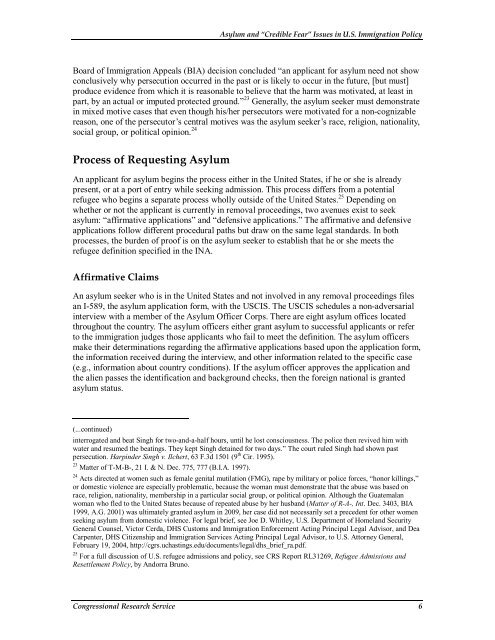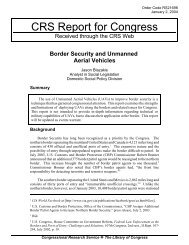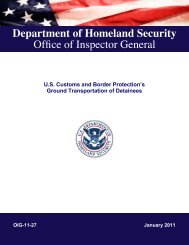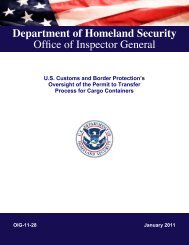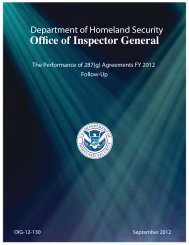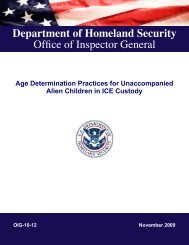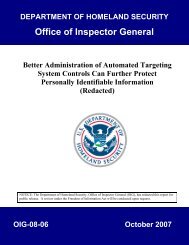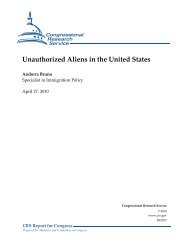Asylum and "Credible Fear" Issues in U.S. Immigration Policy
Asylum and "Credible Fear" Issues in U.S. Immigration Policy
Asylum and "Credible Fear" Issues in U.S. Immigration Policy
Create successful ePaper yourself
Turn your PDF publications into a flip-book with our unique Google optimized e-Paper software.
<strong>Asylum</strong> <strong>and</strong> “<strong>Credible</strong> Fear” <strong>Issues</strong> <strong>in</strong> U.S. <strong>Immigration</strong> <strong>Policy</strong>Board of <strong>Immigration</strong> Appeals (BIA) decision concluded “an applicant for asylum need not showconclusively why persecution occurred <strong>in</strong> the past or is likely to occur <strong>in</strong> the future, [but must]produce evidence from which it is reasonable to believe that the harm was motivated, at least <strong>in</strong>part, by an actual or imputed protected ground.” 23 Generally, the asylum seeker must demonstrate<strong>in</strong> mixed motive cases that even though his/her persecutors were motivated for a non-cognizablereason, one of the persecutor’s central motives was the asylum seeker’s race, religion, nationality,social group, or political op<strong>in</strong>ion. 24Process of Request<strong>in</strong>g <strong>Asylum</strong>An applicant for asylum beg<strong>in</strong>s the process either <strong>in</strong> the United States, if he or she is alreadypresent, or at a port of entry while seek<strong>in</strong>g admission. This process differs from a potentialrefugee who beg<strong>in</strong>s a separate process wholly outside of the United States. 25 Depend<strong>in</strong>g onwhether or not the applicant is currently <strong>in</strong> removal proceed<strong>in</strong>gs, two avenues exist to seekasylum: “affirmative applications” <strong>and</strong> “defensive applications.” The affirmative <strong>and</strong> defensiveapplications follow different procedural paths but draw on the same legal st<strong>and</strong>ards. In bothprocesses, the burden of proof is on the asylum seeker to establish that he or she meets therefugee def<strong>in</strong>ition specified <strong>in</strong> the INA.Affirmative ClaimsAn asylum seeker who is <strong>in</strong> the United States <strong>and</strong> not <strong>in</strong>volved <strong>in</strong> any removal proceed<strong>in</strong>gs filesan I-589, the asylum application form, with the USCIS. The USCIS schedules a non-adversarial<strong>in</strong>terview with a member of the <strong>Asylum</strong> Officer Corps. There are eight asylum offices locatedthroughout the country. The asylum officers either grant asylum to successful applicants or referto the immigration judges those applicants who fail to meet the def<strong>in</strong>ition. The asylum officersmake their determ<strong>in</strong>ations regard<strong>in</strong>g the affirmative applications based upon the application form,the <strong>in</strong>formation received dur<strong>in</strong>g the <strong>in</strong>terview, <strong>and</strong> other <strong>in</strong>formation related to the specific case(e.g., <strong>in</strong>formation about country conditions). If the asylum officer approves the application <strong>and</strong>the alien passes the identification <strong>and</strong> background checks, then the foreign national is grantedasylum status.(...cont<strong>in</strong>ued)<strong>in</strong>terrogated <strong>and</strong> beat S<strong>in</strong>gh for two-<strong>and</strong>-a-half hours, until he lost consciousness. The police then revived him withwater <strong>and</strong> resumed the beat<strong>in</strong>gs. They kept S<strong>in</strong>gh deta<strong>in</strong>ed for two days.” The court ruled S<strong>in</strong>gh had shown pastpersecution. Harp<strong>in</strong>der S<strong>in</strong>gh v. Ilchert, 63 F.3d 1501 (9 th Cir. 1995).23 Matter of T-M-B-, 21 I. & N. Dec. 775, 777 (B.I.A. 1997).24 Acts directed at women such as female genital mutilation (FMG), rape by military or police forces, “honor kill<strong>in</strong>gs,”or domestic violence are especially problematic, because the woman must demonstrate that the abuse was based onrace, religion, nationality, membership <strong>in</strong> a particular social group, or political op<strong>in</strong>ion. Although the Guatemalanwoman who fled to the United States because of repeated abuse by her husb<strong>and</strong> (Matter of R-A-, Int. Dec. 3403, BIA1999, A.G. 2001) was ultimately granted asylum <strong>in</strong> 2009, her case did not necessarily set a precedent for other womenseek<strong>in</strong>g asylum from domestic violence. For legal brief, see Joe D. Whitley, U.S. Department of Homel<strong>and</strong> SecurityGeneral Counsel, Victor Cerda, DHS Customs <strong>and</strong> <strong>Immigration</strong> Enforcement Act<strong>in</strong>g Pr<strong>in</strong>cipal Legal Advisor, <strong>and</strong> DeaCarpenter, DHS Citizenship <strong>and</strong> <strong>Immigration</strong> Services Act<strong>in</strong>g Pr<strong>in</strong>cipal Legal Advisor, to U.S. Attorney General,February 19, 2004, http://cgrs.uchast<strong>in</strong>gs.edu/documents/legal/dhs_brief_ra.pdf.25 For a full discussion of U.S. refugee admissions <strong>and</strong> policy, see CRS Report RL31269, Refugee Admissions <strong>and</strong>Resettlement <strong>Policy</strong>, by Andorra Bruno.Congressional Research Service 6


